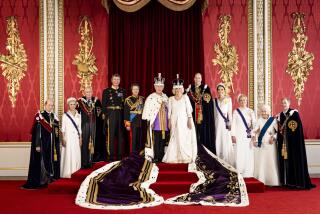House of Windsor, the Wal-Mart of Royal Families
So now we know. The British royal family may be anachronistic, starchy and, in its pleasantly decorative way, somewhat surplus to requirement, but at least it is cheap. According to the latest figures out of Buckingham Palace, the queen and her courtiers cost British taxpayers little more than the price of a medium-budget Hollywood movie in the last fiscal year: 36.7 million pounds to be precise, or about $67 million.
In terms of cost per subject, the House of Windsor represents a setback of 61 pence -- not much more than a buck -- per man, woman and child of the realm. Amortized over the commonwealth, the whole shebang works out cheaper still. Imagine: For the price of the occasional grande decaf latte at Starbucks, you could build global dynasties if only you knew how to be parsimonious enough.
Alan Reid, the Keeper of the Privy Purse (aka the royal bean-counter in chief), refers with satisfaction to what he calls the “value-for-money monarchy” -- a curious phrase, to be sure, coming from an institution whose reason for being is to dazzle its subjects with the allure of ermine, gold and 10 centuries’ worth of fine jewelry.
Value for money was not exactly what Henry VIII had in mind when he took his entire court on a lavish three-week field trip across the Channel in 1520 and vied with the king of France for the most nauseatingly ostentatious display of wealth and finery. The so-called Field of the Cloth of Gold featured gilded fountains spouting claret and spiced wine, tents made of silk and woven with pearls, masked balls, banquets and jousting tournaments. And for what? The diplomatic value of the trip is deemed by most modern historians to have been virtually zero.
Value for money wasn’t one of George IV’s hallmarks either. When he wasn’t gambling or drinking away the exchequer, the playboy son of mad King George III was enacting budget-busting schemes to rebuild central London. At his coronation in 1820, George’s costume was so extravagant and heavy that he almost passed out and had to be revived with smelling salts. One of his critics remarked with disgust that he looked “more like an elephant than a man.”
If times have changed, it is because the monarchy is locked in a struggle to justify its existence. Feudalism, after all, hasn’t been popular for several centuries, and looting and pillaging on behalf of the crown -- one of Henry VIII’s favorite pastimes -- are deemed inconsistent with modern standards of leadership. In the 21st century, royals must behave or risk extinction.
Since the collapse of the British empire, the Windsors have wrestled mightily to live up to a paradoxical expectation: to remain aristocratic and special while somehow adhering, not always successfully, to ordinary middle-class notions of decency and restraint.
The eminent historian David Cannadine has called this (referring to one of the queen’s numerous castles and palaces) the “Balmorality play” of the House of Windsor, a somewhat joyless exercise in pomp and straitened circumstance.
Here, though, is a dirty little secret about the British royals: They have been stingy for far longer than you might think. George IV, the last of the great spenders, suffered endless battles with Parliament because of his profligacy, leading to the emasculation of his plans for Regent’s Street and Trafalgar Square.
William IV described his own coronation as “a pointless piece of flummery” and spent so little on it that it became known as the “Half-Crownation.”
When Elizabeth II acceded to the throne about 50 years ago, she didn’t want to pay for brand-new gilded coaches at her coronation, so she rented them from a film company.
But don’t worry: The Windsors are still capable of the occasional splurge. Prince Charles spent more than $100,000 to charter a plane for Ronald Reagan’s funeral last summer. The queen once packed 147 bags for a four-day trip to Paris.
As Reid, the privy purse keeper, put it: “We’re not looking to provide the cheapest monarchy. We’re looking at one of good value and good quality.”
Elizabeth and Charles, Prince Philip and Camilla -- now there’s quality you can take to the bank.
More to Read
Inside the business of entertainment
The Wide Shot brings you news, analysis and insights on everything from streaming wars to production — and what it all means for the future.
You may occasionally receive promotional content from the Los Angeles Times.










